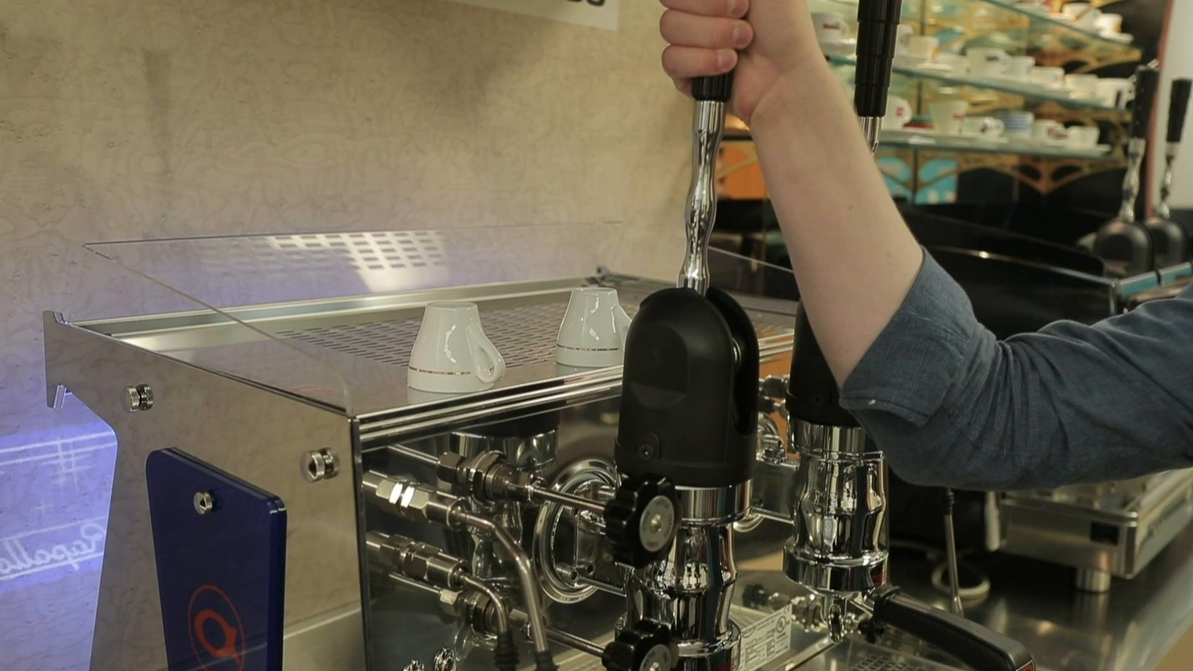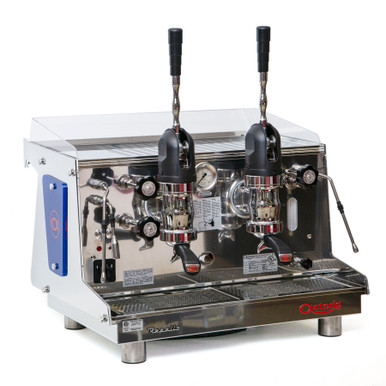Video Overview | Astoria Rapallo AL Lever-Operated Espresso Machines
Transcript
Hey folks. It's Steve with Prima Coffee here. Today, we're going to take a look at Astoria's Rapallo Lever Espresso machine. This is a classically designed Italian-style lever-operated espresso machine. Really, kind of a gorgeous piece of equipment that harkens back to the early days of Italian espresso, back before we were even putting pumps in espresso machines. So, this is a heat-exchanger espresso machine. It's available in two or three groups. And obviously, you'll notice we have these two large levers sticking off these beautifully-chromed exposed groups. So inside this machine, we have either a 10.5-liter boiler or a 17-liter boiler with 4,400 watts or 5,000 watts of heating power. So, it's a heat exchange style espresso machine. We basically just have one big steam boiler that does the majority of the heating and then as water comes through the heat exchangers to the brew groups, it gets heated up, and that's how we heat our water for brewing the coffee itself.
Astoria Rapallo AL Lever-Operated Espresso MachinesAvailable in 2 or 3 Groups
Featured Product
So, the Rapallo can also be outfitted with a propane heater as well, and that would be performed ordering at the factory. But that allows you to cut down your power requirements. Instead of having a 220-volt machine, you could hook it up to propane or natural gas. Now, that does actually cancel out the UL approval, so that might be a consideration for your local health codes, and that sort of thing. But if you need a machine that's a little bit more mobile, something that you could install at a farmer's market, on a coffee cart, in a food truck, or something like that, and you're able to run it on propane, the propane is going to be used to heat the steam boiler. It's a little bit slower in terms of recovery time, so if you're doing a lot of brewing, and a lot of steaming, propane may not be the best option. But if you're in a fairly low-volume environment, it's a good alternative to running on power.
You do still need to have a water supply to the machine, so you might need to still have an accessory pump, a boost pump to provide water pressure to the machine. Or if you're able to hook it up to actual mains water pressure, then you're all set. But that's a pretty good option, again, for mobile settings or settings where you may not have access to 220 power, you would be able to still run the machine, and get it nice and hot. Now, if you're unfamiliar with lever-style espresso machines, what we have here are called spring lever groups. You'll notice obviously I have a big lever handle up here. When I pull that lever down, it pulls a piston up in this brewing chamber, pulls it up and compresses a spring at the same time. When the piston is fully up, the chamber will fill with water and that exposes the dispersion screen and coffee puck to hot water. And then, when I push the lever back up, the piston will be lowered and then it starts to actually apply force to the brewing water via that compressed spring.
So, the extraction of a lever espresso machine is fairly interesting. It's not as static as a other commercial-style pump machine where you have a pump that's applying a fairly constant pressure throughout the entire shot. With a spring-lever machine, because that spring has its highest amount of force being applied as it's like most compressed, you actually see a, sort of, declining pressure profile, where less pressure is applied toward the end of the shot because the spring is basically fully decompressed at that point. So, it's a little bit different. It is a much more manual espresso-making process. But again, this is a very old way of making espresso. Probably, it's one of the earliest ways to make what we know today as espresso because, you know, we didn't quite have pumps back in the day, and this was the closest that you got and it was the best way to apply pressure to the water during your extraction.
Let's take a look at how to actually pull a shot and then we can cover a few other features on this machine. So grinding for a lever-style espresso machine is not exactly that different from a commercial, like, pump machine. It's slightly different again, just because of the way the pressure is applied, you need to adjust your grind slightly. However, if you're not necessarily used to pulling shots on a commercial pump machine, you don't really need to worry about that at all. So now, that I've pulled my lever all the way down, my group is open to the flow of water. So, I'm letting a little bit of pre-infusion happen and then as I raise the lever again, the spring takes over. So now, the spring is actually providing all the extraction pressure. It's forcing water down through the basket extracting my coffee. So, the capacity of the brewing chamber itself is somewhere around two fluid ounces. It's a little fuzzy because that water is flowing. It's under some amount of pressure from the heat exchangers themselves.
So, if you need to extend your shot, you can pull the lever down again, let it fill up a little bit more, and continue to go. So, you can do multiple pulls in a row. You can also, again, like, sort of, hold that lever down a little bit more. You can take it down towards the bottom and kind of pump it a little bit, get a little bit more water that way. So, you are able to get a little bit of adjustment in terms of how much water you push through your coffee during an extraction, but it is a fairly manual process. So, it's a little bit more slow-going than hitting a button and letting the pump run for you. Now, once the spring takes over, you are free to walk away and, you know, maybe prep a milk pitcher, and get some things, you know, take care of, you know, wipe up your counter or something like that. But as a manual-style espresso machine your production is a little bit slower than other machines that have electronics built in. So, it's a little bit more manual. It's a little bit more focused on that, sort of, craft of coffee, and it's not exactly going to be the best machine for high-volume environment.
The 2- and 3-group are probably well- suited for medium-volume cafes, but the 2-group especially it's going to be a great machine to have in a lower volume setting where, you know, your customers might have a little bit more willingness to come and hang out, sit at the bar, talk to the barista, watch them pull a shot, it's very, you know, hands-on process. It gets them very connected to the craft of making coffee. Now, we do have two steam wands on this machine plus a hot water tap, not anything very fancy here, just four-hole steam tips. They are not cool-touch steam wands and the hot water tap does not have any cool water mixing or anything like that. So, it's just straight hot water from the steam boiler itself. Plenty of steam power here.
Again, it's a heat exchange espresso machine, so it's basically one big steam boiler inside, lots of steam pressure, lots of power, so you can do a pretty good job of cranking out lots of straight espresso shots or milk drinks, cappuccinos, lattes. We don't have a ton of group clearance under here. It's intended mainly for, you know, pouring into porcelain or into shot glasses, and then transferring to a cup as you like. Again, a very sort of classically-styled lever espresso machine, obviously, has these kind of classic, sort of, '60s era lines and a beautiful blue light on the back. So, it's definitely a nice display machine to have to present to your customers. And that is the Rapallo Lever Machine by Astoria. Thanks for watching.




